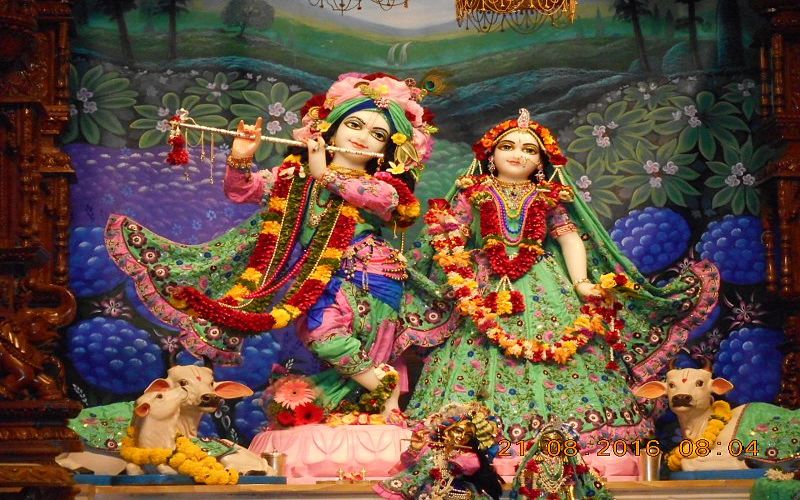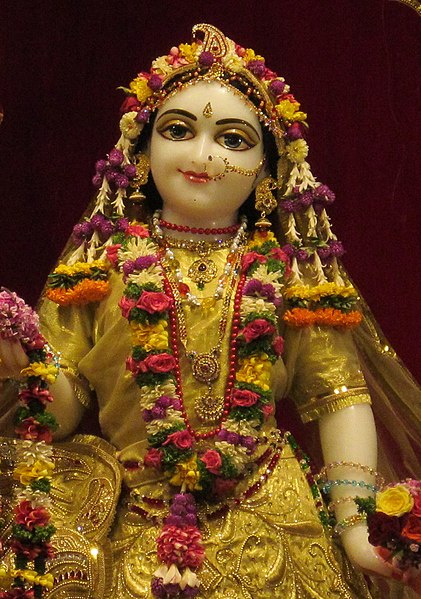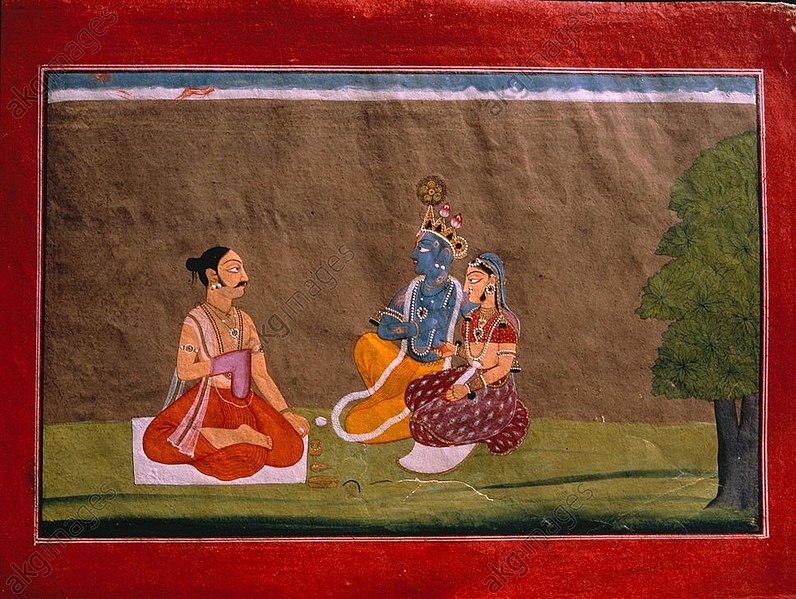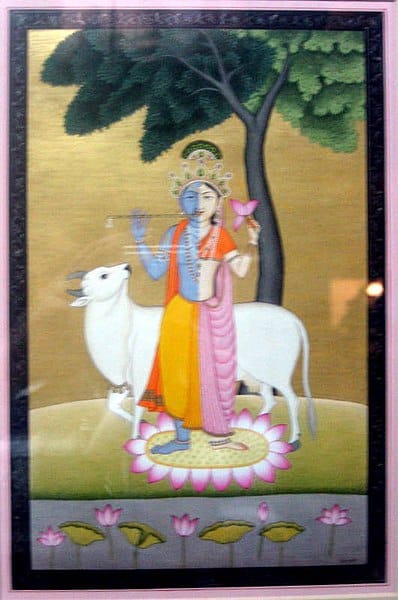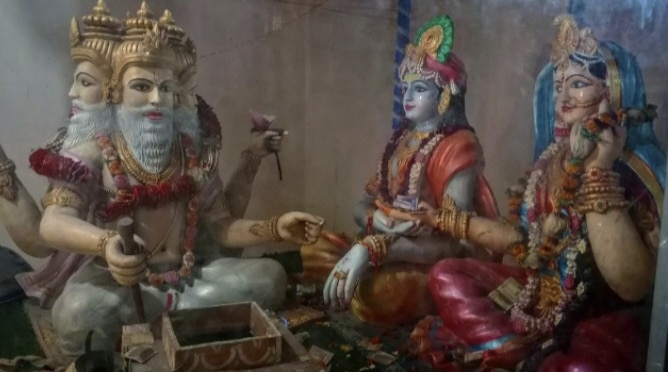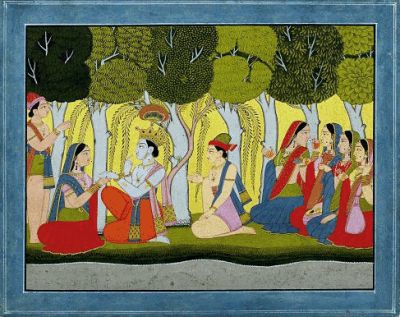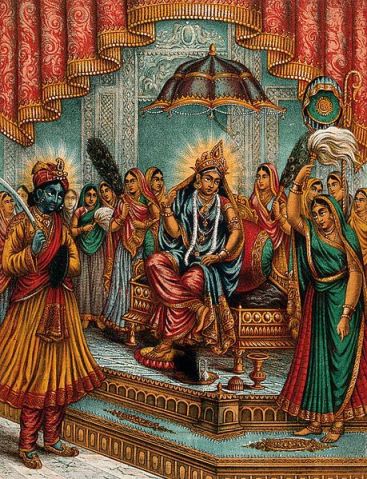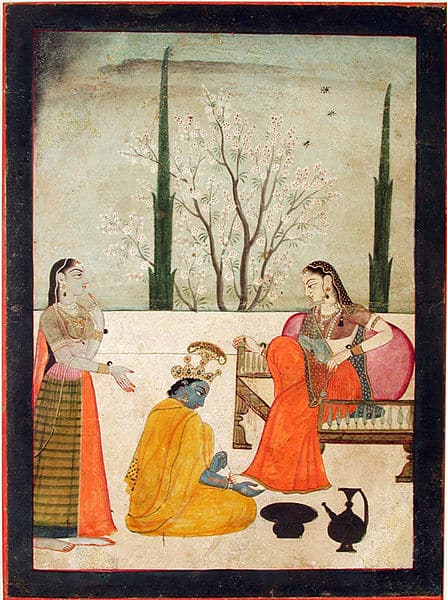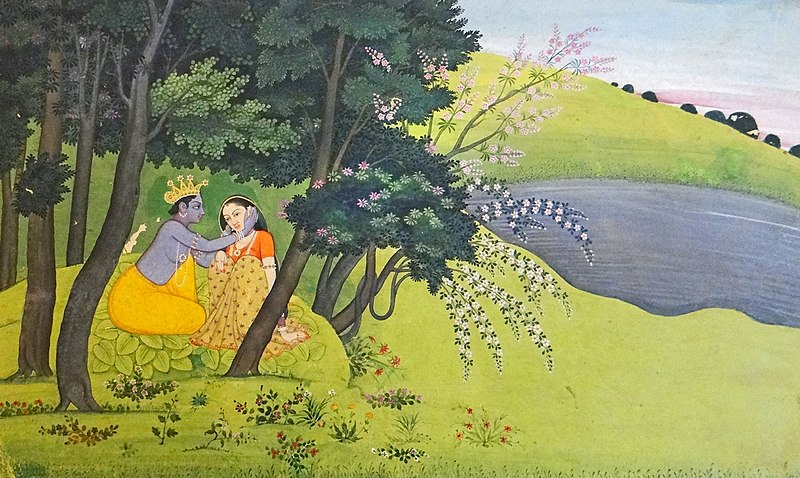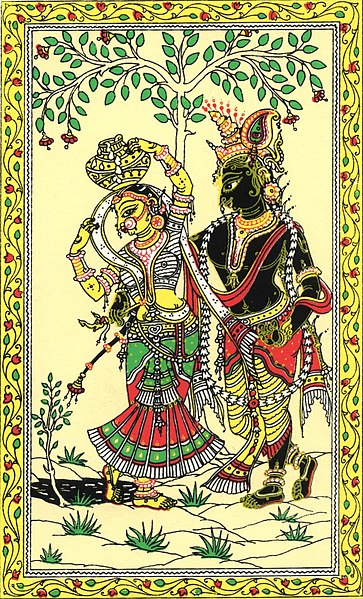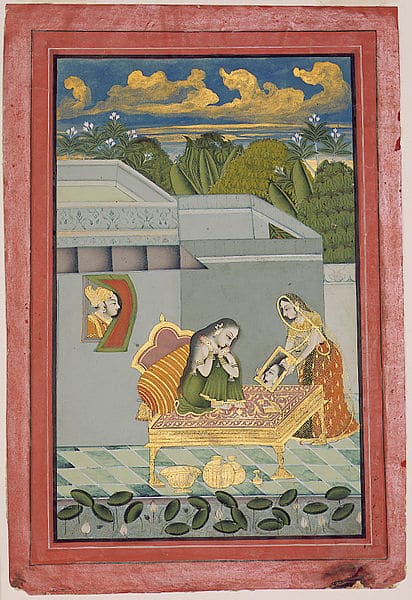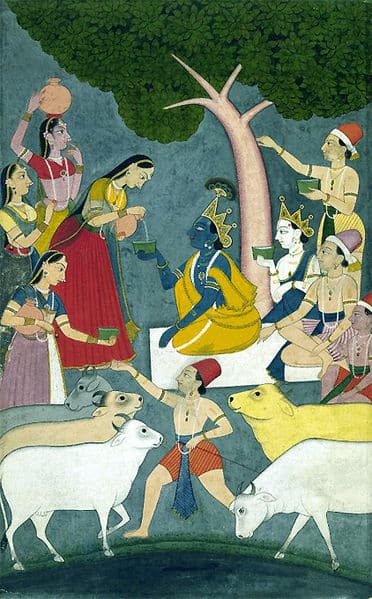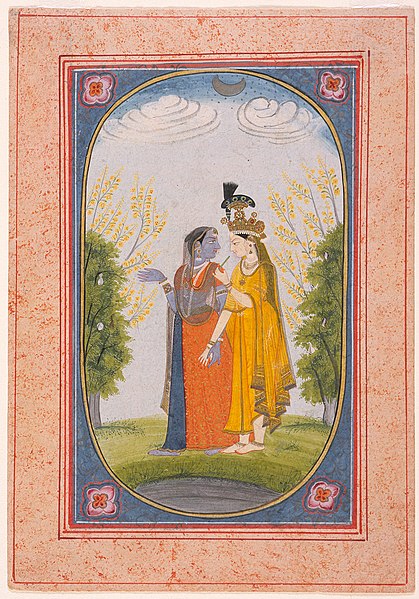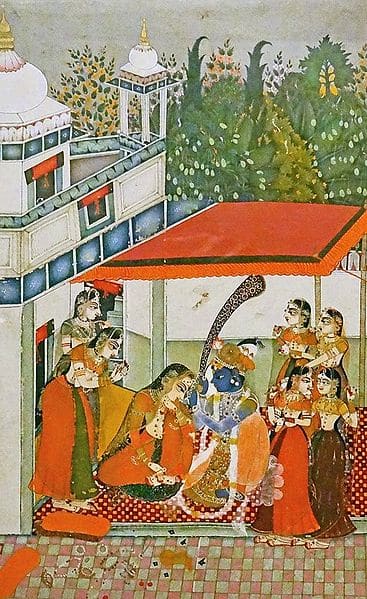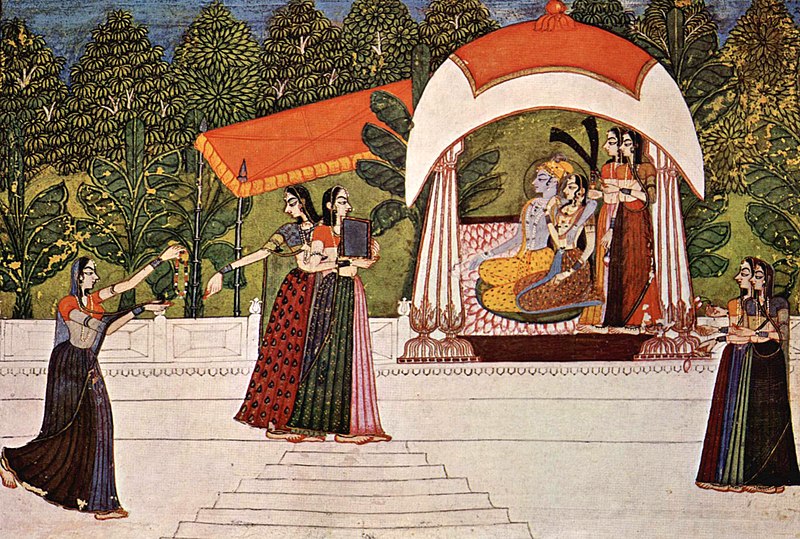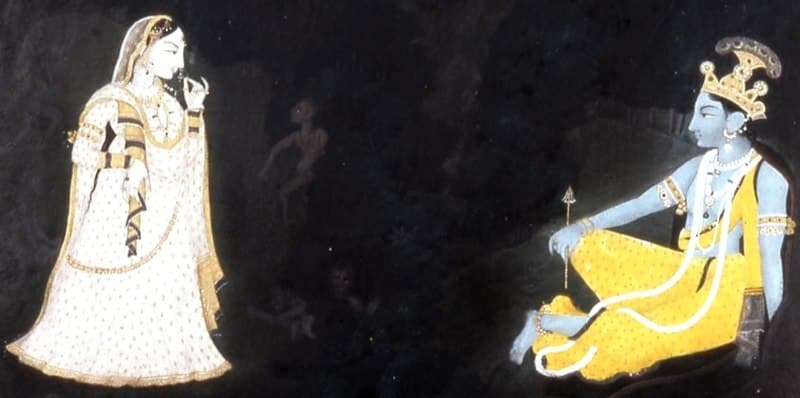According to the philosophy of Hindu Dharma, love is the essence of the universe. It is this divine love that keeps the cosmos going and sustains all creation. Goddess Radha, in her supreme devotion for lord Krishna, is a symbol of that divine love. She personifies the unconditional spiritual root from which everything originates.
Just as Shiva and Shakti are the two fundamental forces creating and sustaining the universe according to the Shaivite tradition, lord Krishna and Devi Radha are the two vital forces running the universe, as per the Vaishnavite tradition. Lord Krishna is viewed as the supreme manifestation of reality and Radha Devi is his female equivalent.
In Hindu Dharma, masculine and feminine forces are equally important for giving shape, form, and meaning to the universe. Therefore just like Shiva and Shakti, Krishna and Radha symbolize the masculine and feminine aspects of the divine consciousness. The divine union of Radha and Krishna is thus the cosmic Raasleela (a term used for the playful banter of Radha and Krishna). This cosmic Raasleela unlocks the secrets of the metaphysical world, teaching us about the primacy of unconditional devotion while seeking the divine, thus paving the way for moksha or salvation.
In the multidimensional pantheon of Hindu Goddesses, Devi Radha is perhaps the only one who lends herself the most to multiple interpretations. She is also the only Hindu Goddess to have inspired works of literature in India to such a great extent. Goddess Radha is venerated as the Goddess of affection, empathy, tenderness, and devotion.
Radha Devi in the Pantheon of Hindu Goddesses
In Hinduism, Radha Devi is the consort of lord Krishna who is an avatar ( manifestation ) of lord Vishnu. Devi Radha is portrayed as the chief of Gopis ( milkmaids ).
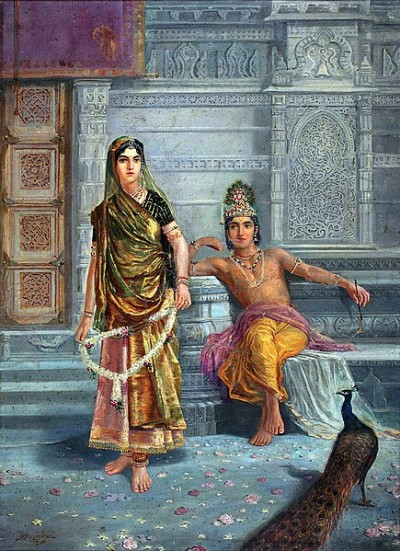
Also known as Radharani, Goddess Radha lives with lord Krishna in Goloka, the celestial residence of Radha and Krishna. Devi Radha is considered the incarnation of Goddess Lakshmi. Even though Radha was never lord Krishna’s wife officially; he had many queens of whom the main one was Rukmani, it is believed that all wives of lord Krishna were actually the manifestation of Radha Devi. The divine love of Radha and Krishna is such that it is beyond societal customs. That is why Radha Krishna’s love often becomes a metaphor for spiritual love or yearning for the divine.
There is no reference to Devi Radha in the Vedas and the early Puranas. But she is often referred to in the late Prakrit literature which is approximately 1,000 years old. It is in the epic work Gita Govinda composed by the 12th century Hindu poet Jayadeva that Goddess Radha’s celestial beauty, her persona, characteristics, and the divine love story of Radha and Krishna is described.
Also, Radha is mentioned in the later Puranas, such as the Brahma Vaivarta Purana which is less than 600 years old. In this Purana, Radha and Krishna are described as the male and female principles of the universe respectively.
Devi Radha and lord Krishna are mostly worshipped together in temples and Hindu households through the veneration of their murtis ( idols ) or pictures.
The Symbolic Significance of Radha Devi
In the tapestry of Hindu spirituality, Radha Devi is revered as the epitome of Bhakti (devotion). Her love for Krishna is not bound by worldly constraints but is seen as the highest form of devotion. It’s a a love that is both pure and selfless as well as transcendent. This unconditional love is symbolic of the soul’s eternal quest for union with the divine. This makes Radha a spiritual beacon for devotees seeking to deepen their own path of devotion.
In the celestial realm of Hindu mythology, where deities embody profound spiritual truths, Radha Devi stands as a paragon of devotion and unconditional love.
Revered as the eternal consort of Lord Krishna, Radha’s presence in the pantheon is not just as a divine figure but as the embodiment of pure, selfless love. Her story, deeply woven into the fabric of Hindu spirituality, transcends the boundaries of mere mythology, resonating as a symbol of devotion and spiritual longing.
Lord Krishna and Devi Radha as One
If lord Krishna symbolizes the divine, Devi Radha’s deep love for him epitomizes the craving of every devotee for the ultimate unification with the divine. Radha was the supreme worshipper of Krishna. But the boundaries between Radha and Krishna are blurred. That is why Devi Radha and lord Krishna are often regarded as one. Together, they become a vital symbol of the power of devotion.
That is why even though Radha and Krishna’s love story is often narrated in worldly terms through various works of literature and performance arts, their love story is not a temporal one. Radha and Krishna’s love story is symbolic of the immense power of faith and devotion. When you seek the divine with all your heart, losing yourself in the process, you become one with the divine. That is why the celestial love of Devi Radha and lord Krishna is often invoked as a metaphor in the Bhakti tradition of poetry and literature.
Devi Radha in the Context of Hindu Theology
Devi Radha’s significance in Hindu theology extends beyond her role as Krishna’s beloved. She is often perceived as the feminine aspect of the divine, her relationship with Krishna representing the union of the individual soul with the supreme consciousness.
This theological perspective places Radha at the heart of the Bhakti movement, symbolizing the soul’s journey towards divine love and enlightenment.
Goddess Radha Origins
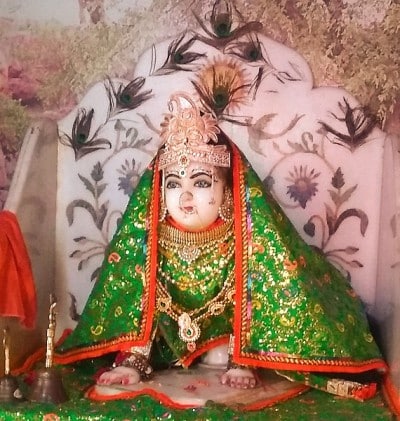
Radha Rani is believed to be born in the north Indian town of Barsana to Kirti(mother) and Vrishbhanu(father).
The Brahma Vaivarta Purana mentions an interesting story regarding the birth of devi Radha in human form. According to legend, Radha Rani resides with lord Krishna permanently in Goloka. Once when Radha Rani was not in Goloka, Shri Krishna was taking a stroll with his other wife Viraja. As soon as Devi Radha came to know about this, she immediately returned to Goloka. Goddess Radha got extremely angry and started calling lord Krishna names in anger.
Upon seeing Devi Radha insult lord Krishna, his friend Sridama got angry and he insulted Goddess Radha. This angered Radha further and she cursed Sridama to be reborn as a demon.
In retaliation Sridama also cursed Devi Radha that she would be born on the earth as a human. Thus, Goddess Radha was born as the daughter of Kirti and Vrishbhanu in Barsana.
Goddess Radha did not take birth from Kirti’s womb
According to the Brahma Purana, after Shridama cursed her, lord Krishna said to Devi Radha that she will have to be born in Gokul as the daughter of Kirti and Vrishbhanu. In the human form, you will be wedded to a man called Raayan who will be my ansh (part) only. Thus, in worldly terms, you will be known as the wife of Raayan.
Lord Krishna also told Devi Radha that she would stay as his beloved in the form of Radha but they will have to be parted for some time because of lord Krishna’s other duties.
Radha’s mother Kirti got pregnant in the view of the world. But legend has it that Devi Radha didn’t enter her womb. With the help of Yogmaya, Kirti gave birth to wind. With the birth of wind, Goddess Radha manifested herself in the form of a little girl. Thus, it is said that Devi Radha wasn’t born from her worldly mother’s womb.
Other Stories of Goddess Radha Origin
According to another legend, Devi Radha originated from the Pauranik story of Aditi, the mother of all Gods. As per this theory, Goddess Radha is considered an avatar of Devi Aditi who was born during the churning of the oceans and appeared on the earth as Radha to accompany lord Krishna in his earthly incarnation.
Goddess Radha Representation
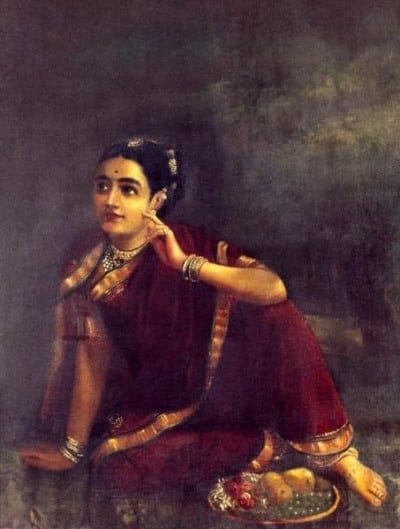
Devi Radha is often depicted as a fair complexioned Goddess with unparalleled celestial beauty. There is no standard template for depicting Goddess Radha. Multiple artists have depicted her in different hues according to their subjective interpretations and taking creative liberty. But she is mostly portrayed adorned in a brightly colored lehanga( traditional Indian skirt also worn by brides) as well as a blouse and a chunri or dupatta ( scarf draped around the waist and head). In some depictions, she can be also seen wearing brightly colored sarees in various shades of red, pink, blue, etc.
Devi Radha is seldom depicted wearing much jewlery. Rather, she is shown adorned with beautiful flowers. She is often shown wearing a celestial garland of multicolored flowers. In some depictions, she can be also seen wearing a mukut ( headgear) and maang tika ( Indian ornament for decorating the parting of the hair).
Young and Innocent Beauty
Devi Radha has a delicate and innocent beauty, which is more synonymous with the flowering beauty of a young girl rather than a fully grown woman. This quality comes across in various representations of the Goddess. She is often shown holding a lotus and a flute, symbolizing purity and devotion.
Various works of Indian literature describe Radha Rani’s beauty evocatively. Her beauty is often compared to various elements of nature like the moon, the lotus, the forests, etc. Devi Radha is so full of love and devotion for Krishna that her entire being radiates in the divine light of Krishna bhakti. This quality makes her beauty even more ethereal.
Devi Radha is often portrayed along with Shri Krishna. In fact, the divine aesthetic of the love story of Radha and Krishna has inspired many dance dramas that depict the Raasleela ( cosmic dance and banter ) of lord Krishna and Devi Radha.
Radha and Krishna’s Divine Love Story
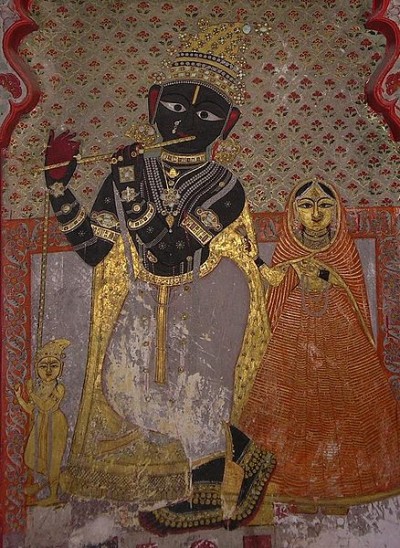
The legendary love story of Radha and Krishna is one of the most celebrated sagas in Hindu mythology. It is a tale that transcends time and space, depicting Radha’s profound love for Krishna.
Their story is set in the idyllic landscapes of Vrindavan, where their divine love flourished. This narrative is not just a romantic tale. Moreover it is a spiritual allegory, symbolizing the soul’s longing for union with the divine.
Devi Radha and lord Krishna’s divine love story is said to have occurred in the Dwapar Yuga ( the third epoch according to Hindu division of time, there are 4 yugas following chronologically according to Hinduism ). Goddess Radha was a Gopi ( cowherdess) who captured lord Krishna’s heart through her charm, beauty, innocence, and playfulness.
The other Gopis are also an integral part of Goddess Radha and Lord Krishna’s love story. Each Gopi of Vrindavan craves Lord Krishna’s love and claims he loves her the most. Devi Radha is often portrayed as being jealous of other Gopis who demand Krishna’s attention. This playful banter between various Gopis and Devi Radha’s jealousy is symbolic of the pinnacle of devotion of the bhakt ( devotee ) towards their aardhya ( the one they worship).
Symbolic Significance of Radha and Krishna’s Divine Love Story
Devi Radha and lord Krishna’s love story is imbued with elements of an idyllic and bucolic rural life. In the realm of Goloka – Vrindavan, Radha and Krishna meet frequently and share feelings and acts of love.
At a symbolic level, Devi Radha and lord Krishna’s love story set in the landscape of Gokul and Vrindavan also embodies an existence full of perfection and ultimate bliss. When the light of divine love enters our life, we are entrenched in its beauty from head to toe.
Lord Krishna is the manifestation of lord Vishnu and Devi Radha is the manifestation of Goddess Lakshmi. During their lifetime as Radha and Krishna, it was preordained that the two would meet in the idyllic rural landscape of Vrindavan and Gokul. There they would fall deeply in love. However, they would then be separated for a long time as lord Krishna would get involved with other responsibilities such as ruling the kingdom of Dwarka.
Raas Leela
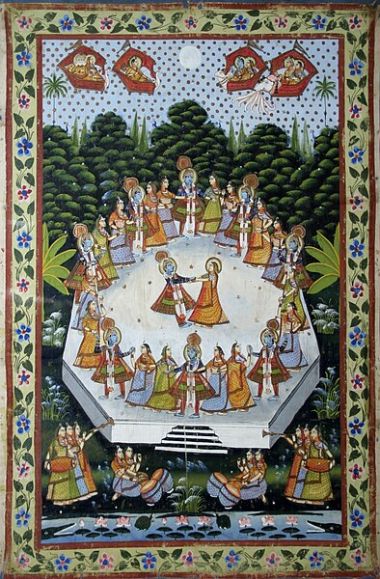
The Raas Leela, a divine dance of love, is one of the most significant episodes in Devi Radha and lord Krishna’s love story.
It is a celestial event where Krishna dances with Radha and the Gopis (milkmaids), each feeling as if they are dancing with her alone. This mystical dance is symbolic of the divine play (Lila) and the soul’s communion with the supreme. The Raas Leela is celebrated as an expression of spiritual ecstasy. The boundaries between the devotee and the divine dissolve in the dance of cosmic love.
The metaphor of Raas Leela has deeply inspired the literary and performing arts landscape of India. The divine love story of Radha and Krishna through the colorful metaphor of Raas Leela is often portrayed in Indian dance dramas based on classical Indian dance forms. Nowadays, more modern interpretations of the Raas Leela are coming to the fore as dance and theatre directors introduce various innovations merging the classical narrative of Devi Radha and lord Krishna within contemporary settings and frameworks.
The metaphor of Raas Leela is often invoked in Bollywood songs and dances at a very superficial level. Raas Leela is not a simplistic party like or carnivalesque celebration of the senses. It’s a metaphor for the total abandonment of one’s ego in their quest for attaining the divine. When the devotion is so deep, the boundaries between the devotee and divine become increasingly blurred till they become one. Radha and Krishna dance in ecstatic abandon till Krishna becomes Radha and Radha Krishna. This is the essence of Raas Leela.
Radha Devi’s Mythological Tales and Legends
There are numerous tales of Devi Radha and lord Krishna that show their deep love for each other. Here are some of these stories.
The Legend of Hot Milk
Radha was officially not lord Krishna’s wife. But Krishna’s endless love for Radha made his wives jealous. According to legend, once all his wives got together and hatched a conspiracy to make Devi Radha suffer.
They poured hot milk into a bowl and offered the milk to Radha saying lord Krishna had sent the bowl. Hearing that lord Krishna had sent it, Devi Radha willingly drank the scorching hot milk without an iota of protest.
According to the legend, when lord Krishna’s wives returned home, they discovered him with painful ulcers. This story demonstrates the fact that the love of Radha and Krishna is so strong that one resides in the pore of the other’s body. The two are inseparable. That’s why Krishna suffered when Radha drank the scorching hot milk.
The Legend of Charnamrit
This story also portrays the deep love between Devi Radha and lord Krishna.
According to the legend, once lord Krishna felt seriously ill. Shri Krishna then discovered he would get better if he could receive the Charnamrit. This is(the water with which one cleanses the feet of a true devotee or worshipper. First, all the Gopis were requested to offer their Charnamrit to lord Krishna so that he could drink it and recover. But none of them agreed. They were scared of offending lord Krishna by making him drink the water with which they cleansed their feet.
However, when Devi Radha got to know about lord Krishna’s illness and the cure, she immediately offered the Charnamrit with utmost sincerity, even if it meant she would have to suffer for her action.
Legend has it that it is because of this incident of Devi Radha offering Charnamrit to lord Krishna that she could never marry him. This tale tells us about the depth of love between Devi Radha and lord Krishna. They were celestial beings and their love was immeasurable. It didn’t matter if they were married in the worldly sense or not.
Other Mythological Tales of Devi Radha
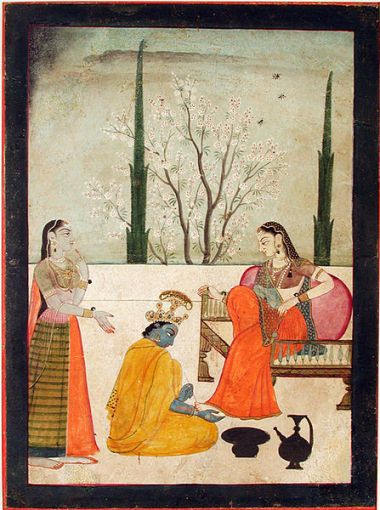
According to legend, when lord Krishna was departing earth for his celestial abode Goloka, he beckoned a divine aircraft that carried along with him all the Brij wasis ( residents of Braj ) and Devi Radha to Goloka.
As per another legend, lord Krishna played his flute so melodiously that Devi Radha showed up in front of him and got joined with his body forever. According to some stories, Goddess Radha had initially emerged from Shri Krishna’s body’s left part. So the merging of Radha’s body into Krishna is symbolic of the unification of the devotee and the divine. When the devotee attains enlightenment or moksha, they merge with the divine consciousness.
Radha Devi in Spiritual and Cultural Context
Radha Devi’s myths, steeped in spiritual symbolism, offer profound insights into the nature of divine love and devotion. Her love for Krishna transcends the physical realm, symbolizing the soul’s eternal quest for union with the divine.
In these stories, Radha’s devotion is depicted not just as an emotional expression, but as a path to spiritual enlightenment, embodying the essence of true Bhakti. Her narratives serve as allegories for the soul’s journey, highlighting the transformative power of devotion in achieving spiritual liberation.
Cultural Impact and Reverence
Radha’s influence extends beyond the spiritual realm into the cultural fabric of India. She is a central figure in various art forms, including classical dance, music, and painting, where her story is portrayed as the ultimate expression of love and devotion.
Festivals like Holi and Janmashtami see special celebrations in her honor, where her love story with Krishna is reenacted, symbolizing the joy and color she brings into the lives of devotees. Her impact on these cultural expressions reflects her enduring legacy as a symbol of divine love.
Radha Devi Literary Impact and Reverence
Radha Devi is an eternal source of inspiration for Indian literature. The poetry composed in the Braj dialect of Hindi, belonging to one of the earliest phases of Hindi poetry known as Reetikaleen Kavy is devoted to describing the celestial beauty of Devi Radha. The subject matter of many Reetikaleen poems revolves around depicting the various episodes of Devi Radha and lord Krishna’s life.
The poetry in this phase of Hindi poetry is devoted to Shringar Ras ( the aesthetic of romantic love, beauty, etc. ) and also Bhakti Ras ( the aesthetic of devotion ). The divine love story of Devi Radha and lord Krishna has lent itself beautifully to both Shringar Ras and Bhakti Ras poetry. In Shringar Ras poems, there will be a detailed description of the beauty of Goddess Radha, her characteristics, mannerisms, her love for lord Krishna, their Raas Leela, etc. through rich and evocative metaphors. In the tradition of Bhakti poetry, the love story of Devi Radha and lord Krishna is explored at a deeper and spiritual level.
The Gita Govinda poem
The most renowned literary work portraying Devi Radha is perhaps the epic poem Gita Govinda written in Sanskrit by the 12th century poet Jaideva. The epic explores the metaphor of love through the poetic narration of various tals woven around the deep love of Devi Radha and lord Krishna. Gita Govinda depicts myriad shades of love from milan ( the ecstasy of meeting the beloved ) to virah ( separation ) when the pain of being away from the beloved takes away all the happiness of the nayika ( female lover ).
Gita Govinda describes the love story of Devi Radha and lord Krishna in evocative terms right from Radha getting attracted to the sound of Shri Krishna’s flute, Krishna getting enamored by Devi Radha’s expressive beauty to all the stages of their milan (union ) and virah ( separation). The epic Gita Govinda explores the divine love story of Radha and Krishna from the point of view of Shringar Ras ( the aesthetic of romance love, etc. ).
Devotion and Worship of Radha Devi
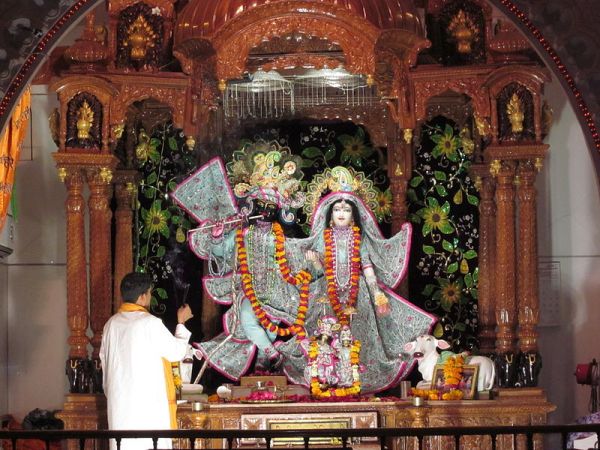
The worship of Radha Devi is marked by various rituals and practices that reflect her spiritual significance. In places like Vrindavan and Barsana, her birthplace, devotees engage in regular singing of bhajans and kirtans, recounting her love and devotion to Krishna. Temples dedicated to Radha witness daily rituals where she is adorned and worshipped, often alongside Krishna, symbolizing their eternal union. The practice of Radha-Krishna worship is a key aspect of devotional Hinduism, emphasizing the importance of love and surrender in spiritual practice.
Devi Radha as a Spiritual Guide
In the realm of spiritual guidance, Radha Devi is revered as an exemplar of devotion. Her unwavering love for Krishna, despite the trials and tribulations, serves as a guiding light for devotees on their spiritual journey. She is seen as a divine mentor, teaching the virtues of patience, perseverance, and unconditional love. Her life’s stories and teachings are a source of inspiration for those seeking to deepen their own spiritual practice and connection with the divine.
Radha Devi’s Manifestations and Forms
Radha Devi, in her multifaceted nature, embodies various aspects that resonate with different dimensions of devotion, love, and spiritual longing. Each of these aspects highlights a unique attribute of her divine personality:
- Radha the Beloved: Revered as the beloved consort of Krishna,. This aspect symbolizes both the pure, passionate love and deep emotional bond shared between Radha and Krishna. It represents the ideal of romantic love elevated to a spiritual plane.
- Radha the Devotee: Epitomizing the pinnacle of devotion (Bhakti), this form of Radha illustrates her unwavering dedication and selfless love towards Krishna. She is the archetype of a devotee whose love for the divine knows no bounds.
- Radha the Compassionate: Often depicted as a compassionate and caring figure, this aspect highlights Radha’s nurturing nature. She is seen as a motherly figure, offering both solace and unconditional love to her devotees. Embodying the caring aspect of the divine feminine.
- Radha the Empowered: In this manifestation, Radha is seen as a symbol of feminine strength and independence. She stands as an empowered woman, whose identity and significance are not solely tied to her divine counterpart but are intrinsic to her own spiritual stature.
- Radha the Mystical: This aspect portrays Radha as the mystical and elusive spirit of the divine. It represents the esoteric and profound spiritual truths that she embodies, often understood and experienced only by those who delve deep into spiritual practices.
- Radha the Eternal Youth: Symbolizing eternal youth and beauty, this aspect of Radha represents the timeless and ever-relevant nature of her teachings and love. It reflects the idea that true love and devotion are always fresh, vibrant, and rejuvenating.
Radha in Various Cultural Depictions
Devi Radha’s portrayals across different cultural contexts vary. Often reflecting the diversity of her worship and the multitude of meanings she embodies.
In classical Indian art, she is often depicted in idyllic settings with Krishna, symbolizing their divine love.
In folk traditions, her portrayals are more grounded, emphasizing her human aspects and relatability. These varied depictions underscore both her universal appeal as well as transcending regional and cultural boundaries. They speak to the universal themes of love and devotion.
Temples and Sacred Sites Dedicated to Radha Devi
The devotion to Radha Devi is centered around several key pilgrimage sites and temples across India. Each holding significant spiritual and historical value. These sacred places are both destinations for worship as well as cultural and spiritual hubs. There the essence of Radha’s divine love is celebrated.
- Barsana: Barsana, the birthplace of Radha Devi, is one of the most revered pilgrimage sites. The town is home to the Radha Rani Temple, situated atop a hill and known for its magnificent architecture. During festivals like Holi and Radhashtami, Barsana becomes a focal point of celebrations, drawing devotees from across the world.
- Vrindavan: Vrindavan is synonymous with the love stories of Radha and Krishna. It houses numerous temples dedicated to Radha, including the famous Banke Bihari Temple and the Radha Damodar Temple. The town is steeped in devotion, with temples, ashrams, and sacred groves. Each of these are narrating tales of Radha and Krishna’s divine play.
- Nidhivan: Nidhivan is a sacred grove in Vrindavan. It is believed to be the place where Radha and Krishna performed their mystical Raas Lila dance. It is considered one of the most spiritually charged places in Vrindavan, with devotees visiting to experience the divine energy and serenity it offers.
- Radha Kund: Radha Kund, a holy pond near Govardhan Hill, holds great significance in Radha Devi’s worship. It is believed to be the place where Radha and Krishna engaged in playful water sports. Pilgrims visit Radha Kund to take a holy dip, especially during the auspicious time of Ahoi Ashtami.
Architectural and Artistic Representations
The architecture of Radha Devi’s temples often reflects the themes of love and devotion. Intricate carvings, ornate decorations, and serene sanctuaries capture the essence of her divine spirit. Artistic representations in these temples, through murals and statues, depict various scenes from her life with Krishna. Often serving as visual narrations of their divine love story. These artistic elements do not only decorate the temples. Instead they also serve as mediums for devotees to connect with the divine energy of Radha Devi.
Festivals and Celebrations of Radha Devi
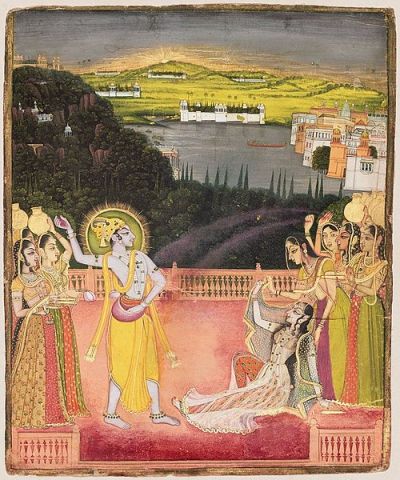
The worship of Radha Devi is marked by several festivals throughout the year. Each celebrating different facets of her divine persona and her relationship with Krishna. These festivals are not just religious observances but also cultural events that bring communities together in joyous celebration.
- Radhashtami: Celebrated as the birth anniversary of Radha Devi, Radhashtami is one of the most important festivals dedicated to her. It falls in the month of Bhadrapada (August-September). Devotees fast, sing devotional songs, and offer special prayers to Radha. Temples are adorned with flowers and lights, and religious processions are often held.
- Holi: The festival of colors, Holi, is intrinsically linked with Radha and Krishna. It commemorates their playful and loving interactions in Vrindavan. During Holi, devotees engage in singing, dancing as well as playfully throwing colored powders and water. This symbolizes the vibrant and joyful nature of Radha and Krishna’s love. Many traditional Holi songs tell the divine love story of Devi Radha and lord Krishna.
The Holi Festivals in Braj and Mathura
It is believed that lord Krishna played Holi with Devi Radha and the other Gopis. That is why Holi celebrations in Braj and Mathura are famous throughout India. They are known for their distinct flavor and unique traditions regarding the celebration of Holi. Most Holi songs talk about lord Krishna playing Holi with Devi Radha and the Gopis. That is why Holi is considered a festival of pure and boundless love. It is a festival in which the spirit of supreme joy and ecstasy takes precedence over the ritualistic aspect.
Thus, the festival of Holi itself symbolizes the divine Raas Leela of Devi Radha and lord Krishna. The act of applying gulal ( Holi colour ) to the faces of other people, the act of playfully throwing water on people with pichkaris ( water guns), endless singing, dancing, and revelry, these all become symbols of the eternal Raas Leela of Devi Radha and her beloved Krishna.
- Jhulan Yatra: This festival, also known as the Swing Festival, is celebrated during the monsoon season. It symbolizes the romantic escapades of Radha and Krishna. Idols of Radha and Krishna are placed on swings in the temples and rocked gently by devotees. Usually accompanied by music and singing.
- Sharad Purnima: Known as the Harvest Moon festival, Sharad Purnima is associated with the divine dance of Radha and Krishna. The danse is also, known as Raas Leela. It is believed that on this night, Krishna multiplied himself and danced with Radha and all the Gopis. Special night-long prayers and celebrations are held under the full moon.
Rituals and Customs in Devi Radha’s Festivals
These festivals involve various traditional practices. Such as singing bhajans (devotional songs) and performing dance dramas depicting scenes from Radha and Krishna’s life. Finally they also offer special food items to the deities. The celebrations are often community-driven, with people gathering in temples and public spaces to participate in the festivities. These rituals and customs not only honor Radha Devi but also reinforce the community’s bond through shared devotion and joy.
Symbols and Icons of Goddess Radha
Radha Devi is often associated with the color red, symbolizing love and passion.
The flute, often depicted in Krishna’s hands, is also a symbol closely associated with Radha. It represent the call of the divine that beckons the soul.
The lotus flower, symbolizing both purity and spiritual awakening, is another icon often linked with Radha. It reflects her pure and divine nature.
Plants, Animals, and Other Elements Linked to Radha Devi
The Tulsi plant, considered sacred in Hinduism, is closely associated with Radha and Krishna’s worship.
The peacock, with its beauty and grace, is another element often linked to their divine play. It symbolizes both the vibrancy and joy of their love.
These natural elements are not just symbolic but are integral to the worship and rituals dedicated to Radha Devi.
Reflection and Closing Thoughts
Radha Devi’s life and legends teach profound lessons about love, devotion, and spiritual longing. Her unconditional love for Krishna, transcending worldly bounds, serves as a guiding light for spiritual seekers. Her devotion exemplifies the path to divine union, teaching us the virtues of patience, perseverance, and unwavering faith.
Embracing the Divine Love
Contemplating Radha Devi’s role in Hindu mythology, we are invited to explore the depths of divine love and spiritual connection. Her story is a reminder of the soul’s eternal quest for union with the divine. She is forever encouraging devotees to seek a deeper, more meaningful relationship with the spiritual realm. Understanding Radha’s role enhances our comprehension of divine love, guiding us on our own spiritual journeys.
FAQs about Goddess Radha
The town of Barsana in the north Indian state of Uttar Pradesh is the birthplace of Goddess Radha.
Radha Devi is a manifestation of Goddess Lakshmi.
The divine dance of Devi Radha and lord Krishna is known as Raas Leela.
The eternal abode of Devi Radha is Goloka where she resides with her consort lord Krishna.
The epic poem describing the divine love story of Radha and Krishna is known as ‘Gita Govinda”.
Gallery
- Radha at ISKCON Temple, Pune
- Jayadeva recites the mantra to Radha Krishna by Manaku.
- Radha Krishna ardhanarishvara form
- Radha Krishna’s marriage is being performed by Brahma in Bhandirvan, Vrindavan
- Radha and Krsna Seated in a Grove with Gopis and Gopas. Painting from a Rasa Panchadhyayi series. In the style of Bhagvan. Kulu, c. 1790-1800
- Radha depicted as Supreme goddess while Krishna humbly stands in front of her.
- Krishna painting feet of Radha, 1760 art form based on Braj’s Rasikapriya text.
- Radha Krishna painting inspired by Gita Govinda
- Patta Chitra painting depicting love story of Radha and Krishna.
- Rajasthani Painting with a love theme where Radha is getting ready and Krishna admires her silently
- Pahari painting of Radha offering bowl of curd to Krishna.
- Kangra painting, Radha dressed as Krishna and Krishna dressed as Radha.
- Rajput painting (1760), Radha Krishna with gopis.
- Kishangarh painting, Radha Krishna in pavilion
- Radha meeting Krishna on a stormy night

